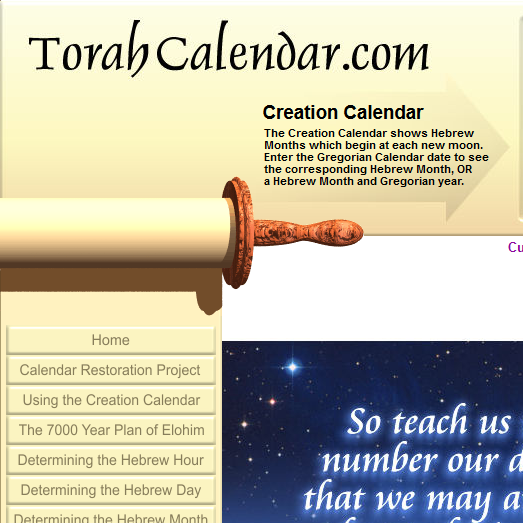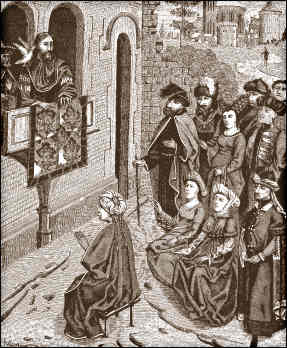|
|



Creation Calendar
The Creation Calendar shows Hebrew 
Isaiah 53 from the Aleppo Codex











Welcome to Torahcalendar.com
The Calendar Restoration Project is a historical work in progress to restore the Creation Calendar of Scripture.
Based on the whole counsel of Scripture, it is evident that the Creation Calendar is a 7000 year calendar modeled
on the seven days of creation. It is composed of 140 Jubilee Cycles of 50 years.
From Psalm 90:4 and 2 Peter 3:8, the Scriptures teach that the Seventh Millennium, which is the Millennial Sabbath and the Age of Life with יהושע Messiah, will begin after 6000 Years since the true epoch of creation. We believe the Sabbaths, New Moons, Appointed Times and Festivals of יהוה have been correctly restored. We also believe that this site correctly teaches how to determine the Hebrew Hour, Hebrew Day, Hebrew Month and Hebrew Year. We are watching, hoping, and praying that the Messiah will come soon. The final goal of the Calendar Restoration Project is to successfully determine the true epoch of creation. יהושע Messiah is not delaying His coming, but will come on time at the restoration of all things as prophesied by Peter in Acts 3:21. We must all keep watching as the Master has said, to see something many have longed to see - the resurrection of the just. By entering this website you acknowledge that the date posted for the epoch of creation is provisional, and is conditional upon historical proof which is not yet published. Certain very ancient historical dates before Moses which are provided in articles on this site should still be considered provisional at this time. The Calendar Restoration ProjectThe Creation Calendar at TorahCalendar.com is a faithful restoration of the original calendar used since creation. Research derived from a combination of sources including the Scriptures, ancient historical records and advanced lunar and planetary motion theories has culminated in the restoration of the Creation Calendar. One of the purposes of this effort has been the restoration of the Scriptural reckoning of hours, days, months and years based on the positioning of the earth, moon and sun as was done in ancient times. 
An Electronic EyewitnessScientific advancements in the field of celestial mechanics have increased rapidly since the mid 1980's. For decades, advanced technology has allowed scientists to characterize and understand the complex motions of the moon and its distance from the earth. As a result, powerful analytical theories for predicting the positions of the moon and the planets have emerged. Considering the tremendous advancements in computing power in recent years, the time has finally arrived when it is possible to precisely determine the positions of the sun, moon and earth for any point in time. Lunar and solar position computations used in restoring the Creation Calendar at TorahCalendar.com are obtained from a C program component provided by Stephen L. Moshier. This program adjusts the ELP2000-85 analytical lunar theory of Chapront-Touze and Chapront to fit the Jet Propulsion Laboratory's DE404 long ephemeris on the interval from 3000 B.C.E. to 3000 C.E. The precision of the lunar ephemeris in the Creation Calendar computes timing for the exact position of the moon accurate to within ±30 minutes at 4000 B.C.E. The Creation Calendar program places Day 15 of Month 1 on or after the Hebrew Day of the spring equinox. The new moon is determined by the criteria of the first possible, visible, lunar crescent as seen from Jerusalem, assuming ideal viewing conditions. This criteria was used by Israel when Jerusalem became its capital. The Creation Calendar was still used during the Second Temple period during the time of יהושע the Messiah. The Creation Calendar, first used by Adam and Hawah at the beginning of creation, was largely abandoned after the Judeans were dispersed after the failed Bar Kokhba revolt in Year 18 of Hadrian in 134 C.E. It was eventually replaced by the modern Rabbinic Calendar in 359 C.E. by Hillel II during the reign of the Roman Emperor Julian the Apostate. Hillel II was the "Nasi," or president, of the Sanhedrin between 320 - 385 C.E. The Creation Calendar is not the Rabbinic Calendar, but is a retro-calculated and forward calculated calendar based on a precise scientific knowledge of the complex motions of the moon. The Creation Calendar implements the rules followed by Israel from the time it was established as a nation under Moses in 1437 B.C.E., until the time that Hillel II changed times and laws during the reign of Julian the Apostate in 359 C.E. The goal of the Creation Calendar Restoration Project is to accurately retro-calculate the first seven days of creation. The Creation Calendar at TorahCalendar.com serves as an electronic eyewitness for determining when any new moon is potentially visible in Jerusalem. This becomes especially useful when the new moon cannot be sighted in Jerusalem due to smog, haze, pollution or clouds. Its true potential value, however, is that it accurately reconstructs the new moon as seen from Jerusalem in the historical past and far off into the distant future. It is for those desiring to observe the appointed times of יהוה according to stringent scientific, historical and Scriptural requirements. The moon has been established as a faithful witness for this purpose (Psalms 89:37). Other Scientific ConsiderationsComparing accurate ephemeris results against observations of eclipses recorded in ancient times, scientists have determined that the earth's daily rotational rate is slowing down. This is caused by tidal friction resulting in the gradual transfer of kinetic energy from the earth to the moon. Using the accepted coefficient of lunar tidal acceleration value of -25.858 ± 0.003"/century², the program driving TorahCalendar.com corrects for these effects. To find the time of day (Universal Time) for any date in history using astronomical ephemedrides, a time correction known as Delta T must be used to correct for this gradual change in earth's rotational rate. Delta T is determined by subtracting Universal Time from the theoretical uniform Terrestrial Time scale (TT). Practical realization for determining precise TT became possible beginning in the 1950's with the invention and refinement of the modern Cesium Atomic Clock. In the Creation Calendar, the new moon is indicated on the day of the Rosh Chodesh - the first visible crescent which follows after the actual astronomical conjunction. Each new moon is calculated from its precise topocentric relation to the sun. The angular distance between the sun and moon, called the Arc of Light (ARCL), and the amount of twilight after sundown, known as the Arc of Vision (ARCV), are used to determine if the moon's crescent will be visible from Jerusalem for any given evening.
|


